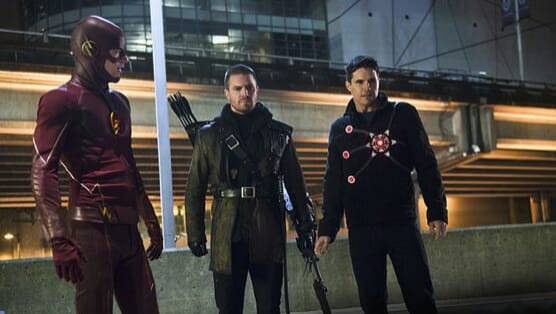The Flash: “Rogue Air”
(Episode 1.22)

After pausing the Harrison Wells storyline with last week’s Grodd-centric installment, The Flash wasted little time in a blistering episode last night that, not only maneuvered all the necessary pieces for the finale, but many for the future as well. In all, “Rogue Air” continued the show’s recent success, culminating a stellar month-long stretch that ranks as The Flash’s best run since its premiere.
The pace at which last night’s episode began was nearly disorienting. Within the first 15 minutes, Team Flash had discovered Harrison’s hideout deep within S.T.A.R. Labs, rescued Eddie, learned the importance of the particle accelerator to Harrison’s plan (though not exactly what he wants to use it for), realized Harrison planned to loose the metahumans on Central City (or simply murder them), and started devising a plan to save said metas. It was the embodiment of a whirlwind, and the speed at which it happened made it feel as though the episode would never find time to allow us to breathe. While the pace remained at a high clip throughout much of the hour, “Rogue Air” was able to find small moments to slow things down just enough to keep the viewer from burning out. It certainly didn’t hurt that a lot of what occurred last night was, more than anything, fun to watch.
Wentworth Miller returned as Captain Cold, whom Barry recruited to help transport the metahumans to Lian Yu, where they could be closely watched in A.R.G.U.S.’ secret super prison. I’ve written before about the oddities of Miller’s performance as Central City’s most infamous villain and, while he still hams up most scenes, it is growing on me. The Flash’s universe is light enough for his broad portrayal to work and often it comes beside (though not last night) Dominic Purcell’s gargantuan turn as Heat Wave, which helps to tamp it down in perspective. As I mentioned, much to the dismay of Joe, Barry enlisted the services of Snart and his sister to help transport the metahumans. Expectedly, Snart double crosses the speedster by compromising the nifty transport vehicle Cisco built that stifled the metas’ powers. This was a clever move by The Flash’s writing staff. The whole metahuman transport scenario worked both within the confines of the Harrison Wells story, but also allowed Captain Cold to build his arsenal of Rogues for future mayhem. I’ve greatly enjoyed the slick way in which the writers have built a relationship between Snart and Barry, making it more than your usual hero/nemesis dynamic and something akin to a twisted symbiotic relationship. The event also served as a teaching moment for Barry in regard to what kind of hero he is. There’s no hiding the fact that Barry has looked up to Oliver and taken notes from the Arrow’s actions in Starling City while learning how to be a protector of his own hometown. But Barry needed to realize that he is not Oliver and their approaches can’t be one and the same. Barry’s choice to trust Snart was that realization. He saw it as “doing whatever it takes,” despite moral ambiguity, for the greater good. He saw it as following in Oliver’s footsteps. But what works for the Arrow doesn’t, and didn’t, work for The Flash because the two have fundamentally different views on the world, which is a very good thing. Arrow has always been dark to a fault, and one of the best aspects of The Flash was that it wasn’t a carbon copy of The CW’s initial comic hit. It took itself less seriously, as did its hero, and that has allowed it to create its own aesthetic—one that feels both similar and incredibly different than its sister show.